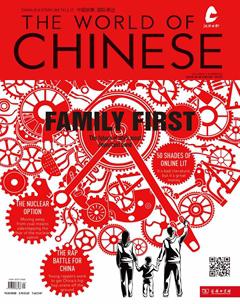GAMBLING ROCKS!
刘莎
The curious practice of staking your savings on getting jade from a stone
赌石:一刀穷,一刀富,一刀穿麻布
Some people get rich quick by winning the lottery, some get a lucky streak at a casino. But some instant millionaires have success etched in stone.
Ruili is a small city near the border of Myanmar—Chinas biggest source of jade imports. This proximity to Myanmars infamous jade mines has meant the city of around 200,000 has become Chinas largest jade distribution center. There, people hold flashlights up to every stone in the market, hoping to find a rock with precious jade inside.
Most, however, have a better chance of going broke after betting all their savings on a seemingly priceless rock which contains nothing of value.
The prices of the irregularly shaped raw stones in jewel stores and vendors carts range from several hundred to millions of yuan, but their real value can only be found after they are bought and cut open—a sort of Schr?dingers stone.
Welcome to one of Chinas oldest forms of gambling.
Raw jade is almost always covered by base material and looks no different from any normal rock, but people often fantasize about the glittering treasures hidden within; this fantasy forms the basis of the traditional business of 賭石, or gambling on stones.
Its a risky business. Neither the buyer nor the seller knows the quality of the stone. Even the most experienced connoisseur will know the old saying, “Even an fairy cant judge an inch of jade (神仙难断寸玉).”
After buying a stone, the buyer will have to consider whether to cut it or not; once open, it is either priceless or worthless.
But, if its not opened, the mystery remains, and it can still be sold to another buyer, perhaps at an even higher price. A common trick is to make a small cut or scrape a bit off the surface. Assisted by a flashlight, buyers can check its color and transparency (important features for nice jade), and thus provide a “window” into the quality of the stone.
If the “window” is transparent enough and has a vivid color, buyers tend to believe there is quality jade inside and the price of this rock will at least double—even though the bare areas might reveal nothing at all about the stones content. Very often, experienced traders, uncertain of the quality, will sell the partly scraped stone to another buyer to transfer the risk.
For jade mine owners, selling the uncut stones to wholesalers is often the best way to make money.
Hundreds and thousands of tons of raw jade are mined every year, but only a small amount is valuable. “If I cut and scrape all my stones before selling them, most of them will be sold cheaply and my business will suffer. The cost is too high,” said a Chinese owner of a jade mine in Hpakant, Myanmars Kachin State. “So I just sell them all to wholesalers and some real professional buyers.”
For many years, its been a common practice to trade raw jade stones, but nowadays, more amateurs, lured by potential fortunes, have flocked into the market to try their luck. Once they start on the road to this adventure, its hard to stop, especially with occasional stories emerging of someone finding a priceless stone among the slurry.
Tan Zhongxing, a jade trader in Chengdu, Sichuan Province, became famous after he bought a raw stone for 60,000 RMB from Myanmar in 2013 and found jadeite inside with seven different colors. “Eventually a jade bracelet was carved out of it and the estimated price went up to 400 million yuan,” he said.
Many people came to Tan to buy the bracelet but he refused them all. Instead he stored it in a safe and its jointly-owned by the National Museum. “I dont want to put a price tag on it, a treasure should be appreciated from both an artistic and cultural perspective,” he said.
Tan was a book publisher for decades and has only been in the jade business for five years, but thanks to the seven-colored bracelet, he is famous among jade traders and the revenue of his shop in Chengdu keeps increasing despite the recent anti-corruption campaign, which has put a damper on luxury products like jade.
Chinese have always put a premium on jade, an obsession that dates back to the Spring and Autumn period (770 BCE – 256 BCE). Confucius once said that jade has the virtues a gentleman should have; its gloss, fine texture, purity, and rigidity signify benevolence, knowledge, righteousness, and loyalty.
The first master of stone gambling was Bian He (卞和), a man said to have lived in the State of Chu. Bian found a jade stone, recognized the value inside, and offered it to his king. The royal jeweler examined it and concluded it was just a stone. The king deemed Bian a liar and cut off his left foot. Later, the kings son ascended the throne and Bian tried his luck again. The new king cut off his right foot. The third king, who saw the man crying for days and nights in front of the stone, finally had his jeweler cut it open to find a large, pure streak of jade, proving Bian a righteous and honest man (with no feet).

